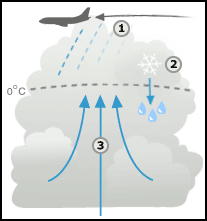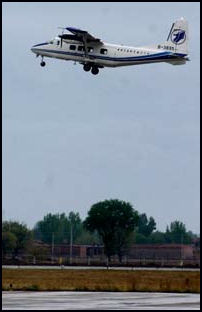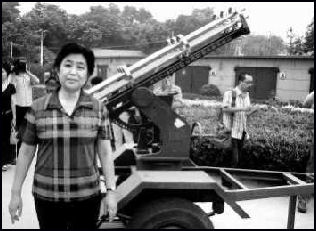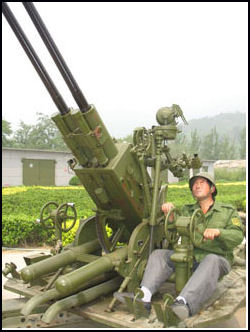RAINMAKING IN CHINA

Cloud seeding
China is the world’s leader in artificial rain making. To induce more rain between April and June, when much of China suffers from drought, scientists use aircraft, rockets, artillery and even land-based furnaces to propel small amounts of silver iodine or liquid nitrogen into certain types of moisture-laden clouds which produce crystals that turn into rain as they fall into warmer areas below. Depending on the type of cloud, dry ice and salt can also be added to enhance the effort. Rain-making doesn’t come without its costs. Occasionally villagers complain of rain-inducing missiles crashing through the roofs of their homes.
China boasts the largest rainmaking program in the world ahead of Russian and Israel. According to the Weather Modification Research Center, China employed more than 50,000 people in the 2000s for the task and used an arsenal that included 6,781 artillery guns, 4,110 rocket-launchers. About 30 modified planes, and some on trucks, were also employed in the struggle to extract rain.
China rain-making operation employs around 35,000 people, according to The Guardian in 2020. In the 2000s, China's rainmaking program had an annual budget of over $100 million and offices in 30 provinces. Between 1995 and 2003, China spent $266 million on rainmaking and $500 million on it between 2003 and 2008. Chinese scientists claim that cloud-seeding can increase precipitation in targeted areas by 10-15 percent. They claim Chinese rainmakers have increased rainfall by 210 billion cubic meters — enough to meet the annual needs of 400 million of China’s 1.3 billion people between 1995 and 2004. The current five year plan calls for an increase of man-made rain of 50 billion cubic meters a year — nearly enough to fill the Yellow River.
In December 2020, China’s powerful State Council said that China’s cloud seeing program would be expanded fivefold and would cover 5.4 million square kilometers (2.1 million square miles) — about 56 percent of China's entire surface area --- and be ready by 2025. The project will be at a "worldwide advanced level" by 2035, the State Council said, and will help alleviate "disasters such as drought and hail" and facilitate emergency responses "to forest or grassland fires." [Source: Bill Bostock, Business Insider, December 4, 2020]
Business Insider reported: In June 2016, China allocated $30 million to its cloud seeding project, and started firing bullets filled with salt and minerals into the sky. A year later, China spent $168 million on a huge supply of equipment to facilitate the project, including four aircraft and "897 rocket launchers," The Guardian said. China's Ministry of Finance wanted to use cloud seeding to create at least 60 billion cubic meters of additional rain every year by 2020.
See Separate Articles CLIMATE OF CHINA: PRECIPITATION, REGIONAL AND SEASONAL VARIATIONS factsanddetails.com ; DROUGHTS IN CHINA factsanddetails.com ; China Meteorological Administration cma.gov.cn
RECOMMENDED BOOKS: “Continent in Dust: Experiments in a Chinese Weather System” by Jerry C. Zee Amazon.com; “Dry Spells: State Rainmaking and Local Governance in Late Imperial China (Harvard East Asian Monographs) by Jeffrey Snyder-Reink Amazon.com; “Weather Modification by Cloud Seeding (International Geophysics Series) by Arnett S. Dennis 1980 Amazon.com; “Aridity Trend in Northern China” by Congbin Fu and Huiting Mao Amazon.com; “Monsoons over China” by Ding Yihui Amazon.com; “Evolution of the Large Scale Circulation, Cloud Structure and Regional Water Cycle Associated with the South China Sea Monsoon During May-June, 1998 (2013) by NASA Technical Reports Server (Ntrs) Amazon.com
Rain Making
Cloud seeding was pioneered in the United States in 1946 by a chemist working for General Electric. Efforts to control the weather in China began in the 1950s when Beijing was given access to “cloud seeding” data from the Soviet Union, China launched a weather-modification program in the 1960s. Today is kept alive at research facilities such as the Beijing-based Study Institute of Artificial Influence on the Weather. Dozens of countries — including the US — have employed cloud seeding.
Cloud seeding" involves spraying chemicals like silver iodide or liquid nitrogen into clouds, where water droplets condense and fall. This is how it works: 1) Silver iodide is fired into cloud using flares on planes or from the ground. 2) Water droplets then attach to these particles. 3)They fall as snow if surface temperatures are below or near freezing, or as raindrops at warmer temperatures. 4) Heat released as the droplets freeze boosts updrafts, which pull more moist air into the cloud.
Guns with shells that explode like fireworks are best for extracting rain from small, clouds while rockets, sometimes shot hundreds at a time, and planes are better for spreading chemicals over a wide area. The techniques are not used for bringing rain clouds to parched areas, only inducing clouds already in a given place to produce rain.
Rain Making Technology
Rain-making shells fired into clouds and preparations dropped from planes usually contain particles of silver dioxide, dry ice, or microscopic hygroscopic (water-absorbing) particles such as calcium chloride salts or liquid nitrogen. The idea is to get the cloud to adhere to the particles, causing water particles in clouds to swell into drops big enough to fall as rain. Particles of silver dioxide resemble ice crystals. Supercooled water droplets in the clouds — too light to fall as rain — freeze on these “nuclei” causing each ice crystal to grow until it is heavy enough to fall as rain.
To prevent rain to a target area clouds are seeded so they dump their rain before they reach the targeted area or are seeded with many small seeds that spread over a wide area and disperse the water droplets making them unlikely to form nuclei large enough to fall as a raindrops. It is clearly an inexact science. One scientist told the Times of London, “You have to choose the right recipe of chemicals for the right kind of cloud. Otherwise it can do the opposite of what you want. And afterwards, how do you tell between man-made rain and natural rain?”
Critics claim there is no proof the technology works and the chemicals can be harmful to the environment. The Chinese have done surprisingly little testing of the methods and few studies are available. According to a report on weather modification presented to the U.S. Congress rainmaking has been marked by “failure to provide scientifically demonstratable successes.”When clouds are seeded and rain falls, rainmakers claim success but who is to say the rain wouldn’t have fallen without seeding. There is no way to tell for sure.”
Rain Making in Certain Areas in China

Plane used for cloud seeding
Among the successes of the Study Institute of Artificial Influence on the Weather was the creation of a rain storm that doused a massive forest fire in Heilongjiang in 1987 and then dispersed before a National Day Parade and Panda Festival.
In eastern Qinghai province, where crops have failed due to lack of rain, rockets filled with liquid nitrogen are fired into clouds. Liquid nitrogen spray causes ice droplets to form and drop as rain. The rainmakers monitor computers that measure air flows and cloud densities to decide when to fire. Scientist claim the efforts have produced 260 million cubic meters of rain and increased the flow of the Yellow River in Qinghai by 1.2 percent.
Twenty-three of China’s 43 provinces have weather modification bureaus. In some places different provinces and city’s fight over the same clouds. The biggest disputes occur when areas at the front of the prevailing wind seed clouds and get rain that might fall in another place further down wind. The effectiveness of the rain-inducing campaigns is a matter of debate. At best rainmaking operations produce only a 10 percent to 20 percent increase in rainfall. Because of wind direction and other variables even when rain is produced it often doesn’t fall where people want it.
Rain-inducing technology can also be used to make snow. In January 2007, rockets were fired into clouds over Changchun in Jilin Province in an effort to ensure there was enough snow there for the Asian Winter Games.
In 2004 four cities in Henan Province accused each other of “cloud theft.”
In February 2009, 12 highways around Beijing were closed by heavy snow after a cloud seeding operation.
Scientists 'Cause' Beijing Snow with Cloud Seeding
Quentin Sommerville of the BBC wrote: “Chinese meteorologists say they brought about Beijing's earliest snowfall in a decade, after seeding rain clouds with silver iodide to ease a drought.The Weather Modification Office sprayed clouds with 186 doses of the chemical to bring rain for the wheat crop, the Beijing Evening News said. But the arrival of a cold front caused heavy snow to fall, disrupting road, rail and air travel. [Source: Quentin Sommerville, BBC, November 2, 2009]
Cloud seeding is often used in China in an attempt to bring on rain. Despite the use of the cloud seeding technique, many scientists remain sceptical of its effectivenessIn February, snow fell after the authorities seeded clouds over Beijing in an attempt to alleviate the dry conditions. However, many scientists - particularly in the UK - remain highly sceptical of the effectiveness of cloud seeding. Even if it is theoretically possible, one of the problems for proponents has been to demonstrate that a rainfall or snowfall was caused by the seeding or simply occurred spontaneously.
Rainmaking Industry in China
Jiangxi Gangsi is one of the nation's biggest makers of cloud-seeding shells. Since 2000, the company has played a key role in China's weather-modification program. Workers on the assembly lines there encase catalytic chemicals — usually silver iodide or liquid nitrogen — in shells, which are fired by cannon or dropped from aircraft, to create water droplets in clouds that will fall as rain. [Source: Jonathan Watts, The Guardian, June 1, 2011]
Government officials encouraged local governments to make continued use of weather-modifying techniques. "We attach great importance to artificial rainfall in the effort to ease the drought," China Meteorological Administration vice director, Chen Zhenlin told The Guardian.
The production of the shells may be hindered by government price controls. Each cloud-seeding shell costs about 1,000 yuan ($140) — a figure that has been set since 2000 — which means there is little financial incentive to boost production. "We proposed a price increase to our senior executives," said Gu. "They sent a team to investigate the cost-production capacity. But these things take time." [Source: Jonathan Watts, The Guardian, June 1, 2011]
Preventing Hail in China

Artillery used in hail prevention To reduce damage from hail storms former military gunners are hired to use 1950s-era artillery and anti-aircraft guns to shoot explosive shells into storm clouds. In some places teams of women are paid $20 a head a month to do this. After receiving orders by radio they shoot into fast moving clouds. One weather station manager told the Los Angeles Times, “Not every attack works, of course...But most of the time, we attack and there’s no hail. We don’t attack and there is hail.”
The women are under relatively little supervision. After two weeks training they are organized into groups of four or five and assigned to a dozen or so mountaintops. They live is small barracks for six months of the year, during the hail season from May to October, with short break for trips home. They work as a team, with a loader, targeter, shooter and commander. Twice a day they contact the local weather bureau on old two-way radios for word on storms and weather conditions. Attacks are only carried out with a direct order over the radio.
In January 2019, state media reported that cloud seeding tactics in the western region of Xinjiang had prevented hail damage to crops by from 70 percent.
Rainmakers and Weather Modification at the 2008 Olympics in Beijing
The Chinese were obsessed with the weather before and during the 2008 Olympics in Beijing. There was an entire newspaper devoted to the topic. Four satellites were positioned to transmit weather data during the Games. Radar systems were upgraded so that storms and rainfall could be predicted for specific venues. The Beijing Weather-Engineering Office hired 32,000 people and set up 26 controls stations to create a “defensive web” around the Bird’s Nest stadium to prevent rain that might dare to fall on the Opening Ceremonies. Weather forecasters ran hourly forecasting meetings; used advance radar to monitor things like approaching typhoons, weather fronts and evening thunderstorms; and employed a super computer recently bought from IBM for “several million dollars” to help to predict the weather and pollution levels.
Chinese officials worked out strategies to try and ensure it didn’t become foggy during the games and when it rained it cleansed out the air but doesn’t interfere with events. Rain makers fire rockets and bombard clouds with rain-producing chemicals in an effort to produce storms before events so they didn’t occur during them. Tests were conducted in July 2007 to determine which rockets worked best dispersing rain clouds and bringing sunshine. One of Beijing’s worst fears was that would rain during the opening and closing ceremonies which were held outside.
A typical rainmaking unit was comprised of eight farmers. When given the signal they rushed to a battery of 1960s-era, 37mm anti-aircraft guns in their village courtyard. Four carried shells, two loaded them and two aimed and fired. One villager told the Times of London, “the telephone rings and you must be there within a few minutes. You check the equipment, take aim and fire. The usual purpose is to prevent hail, but now it is to protect the Olympics.”
Rain Gods and Rituals in 19th Century China

rainmaking artillery used at the 2008 Olympics Describing an incident involving a groups of people praying for rain, Arthur H. Smith wrote in “Village Life in China” (published in 1899): A hired labourer leading the horse had on a wide straw hat. Now it is one of the eccentricities of the inaccurate views of those who pray for rain to non-existent monkeys and to garter-snakes, that they also entertain misconceptions as to the causes which hinder rain. Foreigners carrying umbrellas have been mobbed as the efficient cause of drought. The water-spouts of a new consulate in a treaty-port have been complained of as drawing off the moisture that was meant for the whole province. So in this case the big straw-hat of the rustic was resented as “contra-indicated”—as the physicians say—by the rain-prayers.[Source: “Village Life in China” by Arthur H. Smith, Fleming H. Revell Company, 1899, The Project Gutenberg]
China “is one of the most conspicuous examples of homogeneity the world has ever seen” yet “neither the people nor their rulers have any fixed opinions as to the causes upon which the rain-fall depends. In the province of Shandong a great variety of beings real and imaginary are worshipped to cause the fall of water to adjust itself to the needs of the farmers. Among the divinities thus honoured are the Goddess of Mercy who in the south of China is generally regarded as male; the God of War; the Dragon God, or Lung Wang; and a Tai Wang, which is popularly supposed to be incarnated in a serpent, frequently a water-snake, but in default of that a common garter-snake will do just as well. Whenever one of these Tai Wangs is discovered, it is common to notify the nearest local official, and it is expected that he will go and worship it. Many years ago Li Hung Chang performed this service at Tientsin, where there is a very large temple to Tai Wang. [Source: “Village Life in China” by Arthur H. Smith, Fleming H. Revell Company, 1899, The Project Gutenberg]
“As if these incongruous adjuvants of nature were not enough, there are some who worship Yü Huang Shang Ti, or Pearly Emperor Supreme Ruler, and still others think they have warrant in offering sacrifice and worship to “Sun Ta Shêng,” who is nothing more than an imaginary character in the novel known as “Travels to the West.” Sun was originally a monkey hatched by a process of evolution out of a stone, but his exploits are so many and so striking that the popular mind has7 settled on him as a suitable being to superintend the rain-fall. Yet his worship is apparently limited, and like that of all the divinities mentioned extremely irregular. The same village that worships the God of War now, may worship the Goddess of Mercy next time, perhaps on the principle of judicious rotation.
“Besides all these, there is another and quite a different plan in extensive use. In the ancient but now ruined city of Han Tan Hsien, (in Western Chih-li) there is a temple on the premises of which there is a famous well, in which are a vast number of iron tablets. Whenever there is a scarcity of rain, it is almost always a last resort, after the District Magistrate has made the rounds of all the temples in and about his city, to post off an official messenger to Han Tan Hsien—a journey of several days—to get an iron tablet out of the well. The messenger takes an iron tablet from the city whence he starts on which is inscribed the date of the journey, and the name of the District which makes the petition, and on his arrival repairs to the Taoist temple, where for a certain sum he is provided with another iron tablet taken from the well, into which the tablet now brought is thrown.
“On his return journey the messenger is supposed to eat nothing but bran, and to travel at the top of his speed day and night. His arrival is anxiously awaited. And now emerges a characteristic Chinese performance. The counties through which his route lies are not unlikely just as much in need of rain as the one which sends the messenger: the people of these districts not infrequently waylay the messenger temporarily, and “borrow” his tablet, which is thus “invited” to the other district, and the rain-fall will take place there, instead of in the one to which it ought to belong.
“Among the other eccentricities of rain-producing, is the borrowing of a god from one village for use in another. If he succeeds in getting rain he is taken back in honour; otherwise he is not unlikely to be left where he happened to be deposited when worshipped, the villagers—like a set of commissioners for educational examination—being solely influenced by “results.” In other instances if the god does not show signs of appreciation of the need of rain, he may be taken out into the hot sun and left there to broil, as a hint to wake up and do his duty. A bunch of willows is thrust into his hand, because the willow is sensitive to the smallest moisture. It is a common saying in China that “when the Floods wash away the temple of Lung Wang (the Dragon King) it is a case of not knowing one’s own folks.” Yet this is what constantly happens.
“At first glance it certainly appears singular that so practical a people as the Chinese can put the least faith in mummeries of this sort, but the truth seems to be that very little actual faith is exercised, these performances only taking place in default of an acquaintance with the laws which govern the meteorology of the empire. Besides this, the months in which the most resort is had to such performances are the fifth and the sixth, and these are the ones in which the rain-fall is due. As a limit of some ten days is generally set for the efficacy of these petitions, it is extremely likely that the term will be coincident with a fall of rain, which fall will be credited to the petition; whereas the failure of the petition is set down to some wholly different reason.
Image Sources: Dartmouth College; All Posters com, NASA; UNCCD; Xinhua; AFP; BBC; The Hindu; Gary Braasch
Text Sources: New York Times, Washington Post, Los Angeles Times, Times of London, National Geographic, The New Yorker, Time, Newsweek, Reuters, AP, Lonely Planet Guides, Compton’s Encyclopedia and various books and other publications.
Last updated June 2022
